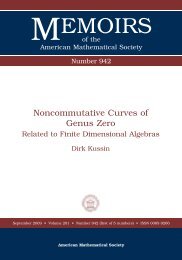University of Paderborn Department of Mathematics Diploma Thesis ...
University of Paderborn Department of Mathematics Diploma Thesis ...
University of Paderborn Department of Mathematics Diploma Thesis ...
Create successful ePaper yourself
Turn your PDF publications into a flip-book with our unique Google optimized e-Paper software.
78 CHAPTER 4. ALGORITHMS FOR STABLE IDEALSMuPAD>> compute_Hilbert_series([[2,0,0],[1,1,0],[0,2,0]], 2);Output3 2poly(2 t - 3 t + 1, [t]), poly(2 t + 1, [t])The output has to be understood as follows: The first expression is a univariate polynomialrepresenting the numerator <strong>of</strong> the non-reduced Hilbert series <strong>of</strong> R/I 1 in the variablet. The second expression is also a univariate polynomial in the variable t. It represents thenumerator <strong>of</strong> the reduced Hilbert series. Hence, 2t3 − 3t 2 + 1(1 − t) 3 is the non-reduced Hilbertseries <strong>of</strong> R/I 1 and 2t + 11 − t is the reduced Hilbert series <strong>of</strong> R/I 1.(ii) Let I 2 := (x 2 0, x 0 x 1 , x 0 x 2 , x 3 1). The set <strong>of</strong> generators is encoded byAgain with n = 2 we obtainMuPAD[[2, 0, 0], [1, 1, 0], [1, 0, 1], [0, 3, 0]].>> compute_Hilbert_series([[2,0,0],[1,1,0],[1,0,1],[0,3,0]], 2);Output3 2poly(2 t - 3 t + 1, [t]), poly(2 t + 1, [t])Thus, the non-reduced Hilbert series <strong>of</strong> R/I 2 is 2t3 − 3t 2 + 1and the reduced Hilbert series(1 − t) 3is given by 2t + 1 as in (i).1 − t(iii) Now, let R := K[x 0 , x 1 , x 2 , x 3 ] and I 3 := (x 0 , x 2 1, x 1 x 2 2, x 4 2). Then, we obtainMuPAD>> compute_Hilbert_series([[1,0,0,0],[0,2,0,0],[0,1,2,0],[0,0,4,0]],3);Output6 5 4 2 3 2poly(- t + t + t - t - t + 1, [t]), poly(t + 2 t + 2 t + 1, [t])i.e. −t6 + t 5 + t 4 − t 2 − t + 1is the non-reduced and t3 + 2t 2 + 2t + 1(1 − t) 4 1 − tseries <strong>of</strong> R/I 3 .the reduced Hilbert
















